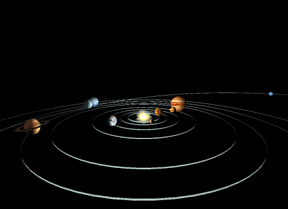Scientists have discovered a solar system similar to ours that has smaller versions of Saturn and Jupiter.
Click on image for full size
Courtesy of KASI - CBNU - ARCSEC (KASI is the Korea Astronomy and Space Science Institute, CBNU is the Chungbuk National University, and ARCSEC is Astrophysical Research Center for the Structure and Evolution of the Cosmos.)
A Newly Discovered Solar System Has Smaller Versions of Saturn and Jupiter
News story originally written on February 14, 2008
For a long time, scientists have wondered if there are other systems of planets like our own in our galaxy. Recently scientists discovered a solar system that has smaller versions of Jupiter and Saturn. This discovery means that there might actually be other solar systems similar to our solar system in our galaxy.
Scientists think the new solar system is smaller version of our own. One of the planets in this solar system is almost almost the same size as Jupiter, and another is almost the same as Saturn. The sun they orbit is smaller than our sun. Their sun is is not as bright as ours, but temperatures at both planets are probably the same as temperatures on Jupiter and Saturn because they are closer to their sun.
Scott Gaudi, one of the astronomers who worked on this project, said that since they were able to see this new solar system, he thinks more of them throughout our galaxy.
You might also be interested in:

The solar system is made up of the Sun, the // Call the planets count function defined in the document head print_planet_count('planets'); planets and // Call the planets count function defined in the
...more
Scientists have learned that Mount Hood, Oregon's tallest mountain, has erupted in the past due to the mixing of two different types of magma. Adam Kent, a geologist at Oregon State University, says this
...more
The Earth's mantle is a rocky, solid shell that is between the Earth's crust and the outer core. The mantle is made up of many different reservoirs that have different chemical compositions. Scientists
...more
Some faults look strong and like they wouldn’t cause an earthquake. But it turns out that they can slip and slide like weak faults causing earthquakes. Scientists have been looking at one of these faults
...more
The sun goes through cycles that last approximately 11 years. These solar cycle include phases with more magnetic activity, sunspots, and solar flares. They also include phases with less activity. The
...more
Studying tree rings doesn't only tell us the age of that tree. Tree rings also show what climate was like while the tree was alive. This means that tree rings can tell us about climates of the past. Two
...more
Earth's first life form may have developed between the layers of a chunk of mica sitting like a multilayered sandwich in primordial waters, according to a new hypothesis. The mica hypothesis, which was
...more















